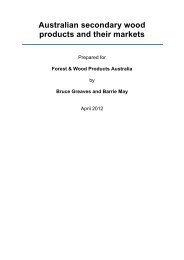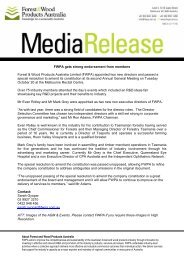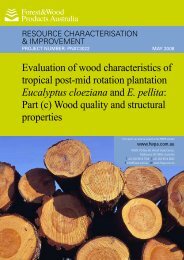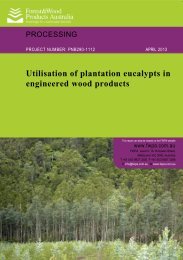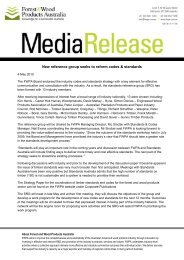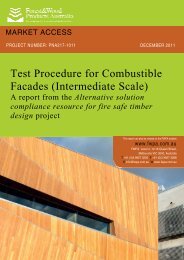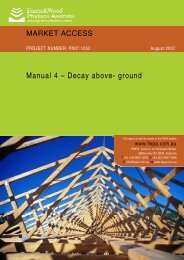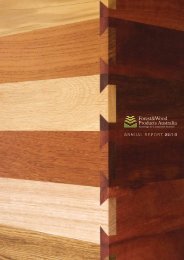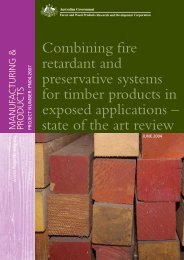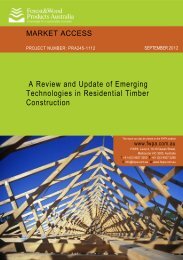Water-use efficient plantations - Forest and Wood Products Australia
Water-use efficient plantations - Forest and Wood Products Australia
Water-use efficient plantations - Forest and Wood Products Australia
You also want an ePaper? Increase the reach of your titles
YUMPU automatically turns print PDFs into web optimized ePapers that Google loves.
(Tang et al 2003). Thus the increase in carbon assimilation in the lower crown of<br />
thinned st<strong>and</strong>s was not accompanied by an equi-proportional increase in<br />
transpiration. Two mechanisms are probably at play: - i) increased irradiance of<br />
lower leaves increased carbon assimilation <strong>and</strong> ii) partial decoupling of the lower<br />
canopy resulting in reduced sensitivity of transpiration to changes in stomatal<br />
conductance.<br />
• Where the native supply is limiting, application of nitrogen increases both leaf <strong>and</strong><br />
st<strong>and</strong> scale water-<strong>use</strong> efficiency. In Pinus pinaster a transient increase in foliar<br />
concentration was associated with increased water-<strong>use</strong> efficiency at a given level of<br />
water stress, suggesting a non-stomatal ca<strong>use</strong> for the improved water-<strong>use</strong> efficiency.<br />
St<strong>and</strong>-scale water-<strong>use</strong> efficiency of E. gr<strong>and</strong>is was also improved by nearly 100%<br />
by improved nutrition (Olbrich et al 1993).<br />
• Irrigation decreased leaf scale water-<strong>use</strong> efficiency (stomata stayed open in irrigated<br />
trees) <strong>and</strong> increased the water-<strong>use</strong> efficiency of dry matter production in P. taeda<br />
(Choi et al 2005).<br />
• Pruning from below also has the potential to improve water-<strong>use</strong> efficiency at the<br />
st<strong>and</strong> scale due to up regulation of the carbon assimilation rate of retained foliage<br />
(Pinkard 2003) <strong>and</strong> the small contribution of the removed foliage to total st<strong>and</strong><br />
transpiration (White et al 2000)<br />
• St<strong>and</strong> scale water-<strong>use</strong> efficiency (Ww expressed in m 3 wood produced per ML of<br />
evapotranspiration) also varies with species (Honeysett et al., 1992).<br />
2. Improving the water-<strong>use</strong> efficiency of <strong>plantations</strong> by breeding <strong>and</strong> application of<br />
st<strong>and</strong>ard plantation silviculture (literature review)<br />
In cereal <strong>and</strong> legume crops it took nearly thirty years from the first attempts to breed for<br />
improved water-<strong>use</strong> efficiency to the widespread evaluation <strong>and</strong> success of water-<strong>use</strong><br />
<strong>efficient</strong> cultivars. Notwithst<strong>and</strong>ing this success, screening of genotypes is prohibitively<br />
expensive <strong>and</strong> water-<strong>use</strong> efficiency is not yet part of any commercial breeding<br />
improvement program.<br />
Leaf-scale water-<strong>use</strong> efficiency is under strong genetic control in trees, but in<br />
environments with winter dominant rainfall leaf-scale water-<strong>use</strong> efficiency is often<br />
negatively correlated with the water-<strong>use</strong> efficiency of wood production. As for cereal<br />
crops, genotypes with weak stomatal response to soil <strong>and</strong> atmospheric water deficits<br />
will concentrate production in winter <strong>and</strong> spring when carbon assimilation is more<br />
<strong>efficient</strong> by virtue of the prevailing conditions. This strategy will grow more wood in<br />
average or good years but will increase the risk of tee deaths during drought years.<br />
Thinning, fertiliser, pruning <strong>and</strong> irrigation all have the potential to dramatically improve<br />
the water-<strong>use</strong> efficiency of wood production. Published studies in eucalypts suggest that<br />
more intensive plantation management will marginally increase water <strong>use</strong> but will have<br />
a profound effect on the water-<strong>use</strong> efficiency of our plantation estate.<br />
8



